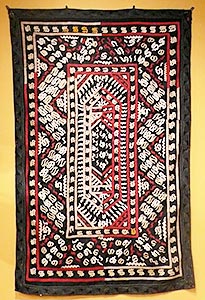Textiles from Central Asia and Turkey ONLINE EXHIBIT
SUZANI 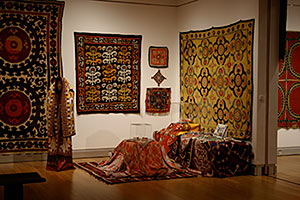
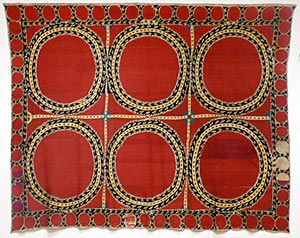
the exit door.
EMBROIDERED COVERS
(Central Asia, Nomadic and Settled)
Small square or rectangular embroideries of various sizes were made to cover or protect just about everything, and are found in both nomadic and urban Central Asia. Embroidered mini curtains covered the wall niches in which blankets and pillows were stored; wall mirrors were covered by Oyna Khalta when not in use; small wall textiles were also formed into pouches for combs or bags for the Holy Koran.


SAYE GOSHA (Segusha)
(Central Asia, Nomadic and Settled)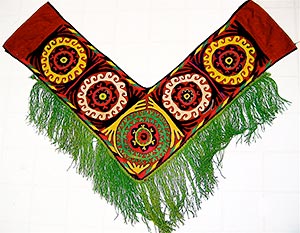
Bedding or other large folded textiles were wrapped in a cloth when they were stored in yurts or village houses during the day. The cloths (Bujgama) used for this purpose had one embellished corner (Saye Gosha) that would be folded so that it decorated the front of the bundle, just underneath the ties. One of these is in the yurt in the large gallery. We have several Saye Goshas that are separated from their Bujgama; those in a “V” configuration are made with a half-cross or petit point stitch and with a long cotton or silk fringe; those that are the lower part of a diamond shaped cotton cloth were once part of wrappers that would be used for smaller items. This type may carry a fringe of hand tied and intricately decorated tassels, often with pieces of metal or amulets.
TUSH KYIZ
(Central Asia, Nomadic)

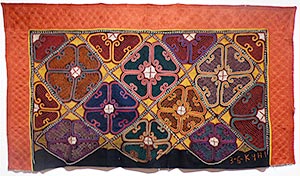
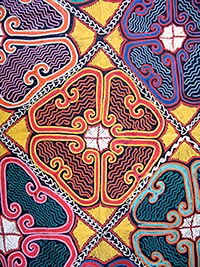
OTTOMAN TURKISH EMBROIDERIES
(Ottoman Empire, Urban)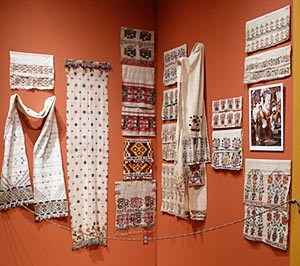
Embroidered silks, cottons and linens formed the dowry of every bride, to be used on ceremonial and household occasions throughout the life of the family. Each type had its own Turkish name. The embroidery on these textiles forms the wide borders on long or very long cloths. A distinctive characteristic of these delicate pieces is that there is no front or back, the stitches are double sided. This allowed both sides to be seen, evaluated, and appreciated. As lightweight homespun towels, they might be draped between a servant’s open arms so that the plain center could be used for the wiping of hands while the embroidered ends fell to each side. Long ones might go from lap to lap as guests sat on floor cushions around a dinner tray. Narrow ones might be a sash or wrapped as a headdress, further ornamented with tatted flowers that moved like tassels. A collection of a family’s, or neighborhood’s small pieces might grace a young boy’s circumcision bed.
Thick towels with a terry weave, the original bath towel, also were embroidered at both ends, often with both real gold and colorful silks if the towel were to be used by a bride before her wedding. The most elegantly worked pieces were used on the nuptial bed on the wedding night as a sheet, capturing the evidence of the bride’s virginity. Also on exhibit is an embroidered large square that was used to cover a turban as it waited on a stand for its wearer. The Ottoman Turkish section has two over-garments (Entari), one for a man, one for a woman, of heavy Bursa silk.
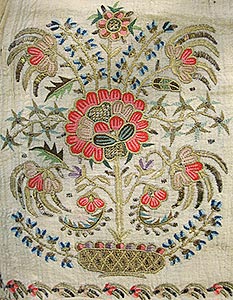
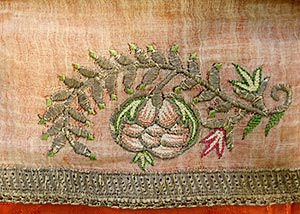
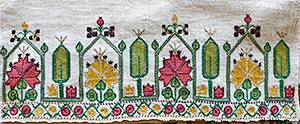
kalpoq, duppi, tup, tubeteika
(Central Asia, Nomadic and Settled)
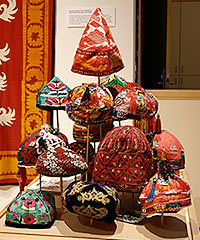 Skullcaps worked in a variety of techniques and materials are worn throughout Central Asia by men and children, and by women on formal occasions. Their distinctive motifs- almonds, paisleys, roses, rosettes, palmettes, stars, tulips, crosses, and zigzags, identify the region of the wearer. Most of our selection belong to children, and have many tassels, amulets and pearls.
Skullcaps worked in a variety of techniques and materials are worn throughout Central Asia by men and children, and by women on formal occasions. Their distinctive motifs- almonds, paisleys, roses, rosettes, palmettes, stars, tulips, crosses, and zigzags, identify the region of the wearer. Most of our selection belong to children, and have many tassels, amulets and pearls.

CHAPANS and CHYRPYS
(Central Asia, Nomadic and Settled)
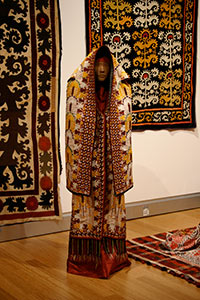
 The Chapan in this room is a refined robe for an urban Uzbek woman, made of Ikat fabric. Men wore similar garments. Ikat silk yarns are dyed before weaving in such a way that they form a pattern on the loom; the slight shifting of the warps creates the pattern’s desired blurry outline. Other Central Asian Chapans are made of striped cotton. Both are most often lined with Russian trade cloth.
The Chapan in this room is a refined robe for an urban Uzbek woman, made of Ikat fabric. Men wore similar garments. Ikat silk yarns are dyed before weaving in such a way that they form a pattern on the loom; the slight shifting of the warps creates the pattern’s desired blurry outline. Other Central Asian Chapans are made of striped cotton. Both are most often lined with Russian trade cloth.
Our exhibit also has embroidered Turkoman robes for women, identified by their lavish embroidery, often with false sleeves that are pulled to the back. These Chyrpys are worn over the head and fall like a cape. Other Turkoman clothing items in our exhibit include a baby’s dress (Elek) with amulets, and a baby’s bib. We also include a Tajik wedding veil. Tajik women did not wear veils except during the wedding ceremony when brides wore a beautifully embroidered Rooband, with open-work stitching to provide a window grid for the eyes.
ruijo
(Central Asia, Settled)
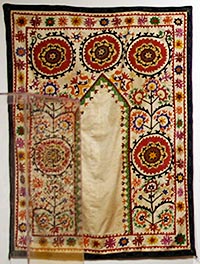
A Ruijo, or bed covering for the bridal bed, is known by its central arch, sometimes pointed at the top, making it resemble the “mihrab” of a prayer rug. These were ceremonial sheets, used on the first night, to capture proof of the bride’s virginity.
CHIMILDIK
(Central Asia, Settled)

The large embroidered velvet piece that surrounds the entry door to the large gallery was probably not for a door but enclosed a fabric, making up a curtain to shield the wedding couple on their first night.
